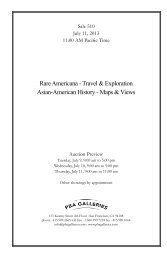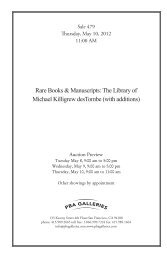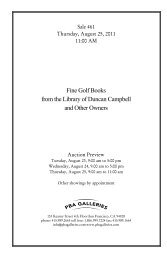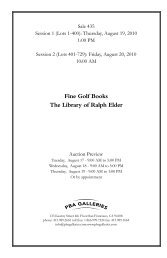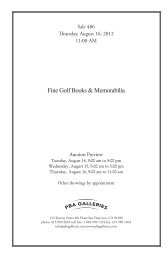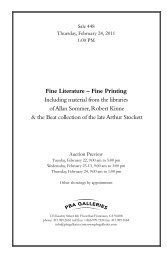The Library of Roger Wagner - PBA Galleries
The Library of Roger Wagner - PBA Galleries
The Library of Roger Wagner - PBA Galleries
You also want an ePaper? Increase the reach of your titles
YUMPU automatically turns print PDFs into web optimized ePapers that Google loves.
110. miller, henry. <strong>The</strong> World <strong>of</strong> Sex - revisions. 42 glossy photographs, each 8x10 <strong>of</strong> Miller’s<br />
holograph revisions. 2 pages <strong>of</strong> text per photograph.<br />
No place: 1957<br />
Miller was told by Olympia Press that they were to publish a side-by-side edition with one page<br />
demonstrating his holograph revisions facing a page <strong>of</strong> the final text. <strong>The</strong> book was published<br />
with only 10 such pages, maddening Miller. <strong>The</strong> photographs show the actual extent <strong>of</strong><br />
revisions and emendations by Miller on the work, which left hardly a sentence unchanged. Near<br />
fine.<br />
(800/1200)<br />
Lot 110<br />
111. miller, henry. “Third Eye Correspondence”. Envelope filled with Miller’s 9-page typed essay<br />
on T. Lobsang Rampa’s book, <strong>The</strong> Third Eye (with numerous holograph corrections by Miller) &<br />
ensuing correspondence from Rampa (Hoskins) to Miller and from Ken McCormick, editor in chief<br />
at Doubleday, to Miller.<br />
Various places: 1957-1958<br />
Fascinating correspondence regarding the famous literary hoax, in which Cyril Henry Hoskin,<br />
a plumber’s son from Plympton, England who had never been to the Orient, masqueraded as<br />
Tibetan lama “T. Lobsang Rampa” and wrote <strong>The</strong> Third Eye, an “autobiographical” account<br />
<strong>of</strong> the lama’s life in Asia, clairvoyant doings, and occult beliefs that was questioned from the<br />
outset. In 1957, before the hoax was revealed, Henry Miller was on a “one- man crusade” to<br />
bring about awareness <strong>of</strong> the importance <strong>of</strong> Rampa’s already controversial metaphysical book,<br />
and to get it published in the United States, and his essay gives many insights into Miller’s<br />
own philosophies despite the hoax. Throughout the correspondence, the hoax is revealed<br />
and Hoskin comes up with a number <strong>of</strong> explanations, one being that he had ghosted the<br />
story for a Tibetan in hiding, another that he was a Tibetan spiritually inhabiting the body<br />
<strong>of</strong> an Englishman, and (my personal favorite) that he had stolen identity papers from a dead<br />
Englishman living in the East and masqueraded as him to move to Ireland, where he resided<br />
at the time <strong>of</strong> the hoax. <strong>The</strong>re are several signed letters from him to Henry Miller, providing<br />
these explanations, and Miller’s letters back to him are very supportive. Throughout their<br />
correspondence, Hoskin’s language get more relaxed, making it quite clear that English is not his<br />
second language, and the two get down to writing about the best & worst literary agents, money,<br />
etc. As Hoskin had sworn Miller to utter secrecy regarding the revelation that he had stolen a<br />
British I.D. <strong>of</strong>f a dead body, the outside <strong>of</strong> the envelope <strong>of</strong> correspondence reads, in Miller’s<br />
hand, “Do not open until after my death - Henry Miller.” Fine - a fascinating group <strong>of</strong> letters.<br />
(600/900)<br />
Page 58



